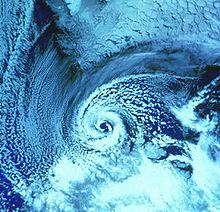- Polar low
-
A polar low is a small-scale, long-lived atmospheric low pressure system (depression) that is found over the ocean areas poleward of the main polar front in both the Northern and Southern Hemispheres. The systems usually have a horizontal length scale of less than 1,000 kilometres (620 mi) and exist for no more than a couple of days. They are part of the larger class of mesoscale weather systems. Polar lows can be difficult to detect using conventional weather reports and are a hazard to high-latitude operations, such as shipping and gas and oil platforms. Polar lows have been referred to by many other terms, such as polar mesoscale vortex, Arctic hurricane, Arctic low, and cold air depression. Today the term is usually reserved for the more vigorous systems that have near-surface winds of at least 17 m/s (38 mph).[1]
Contents
History
Polar lows were first identified on the meteorological satellite imagery that became available in the 1960s, which revealed many small-scale cloud vortices at high latitudes. The most active polar lows are found over certain ice-free maritime areas in or near the Arctic during the winter, such as the Norwegian Sea, Barents Sea, Labrador Sea and Gulf of Alaska. Polar lows dissipate rapidly when they make landfall. Antarctic systems tend to be weaker than their northern counterparts since the air-sea temperature differences around the continent are generally smaller. However, vigorous polar lows can be found over the Southern Ocean.
Structure
Polar lows can have a wide range of cloud signatures in satellite imagery, but two broad categories of cloud forms have been identified. The first is the "spiraliform" signature consisting of a number of cloud bands wrapped around the centre of the low. Some polar lows have the appearance in satellite imagery of tropical cyclones, with deep thunderstorm clouds surrounding a cloud-free ‘eye’, which has given rise to the use of the term "Arctic hurricane" to describe some of the more active lows. These systems are more common deep within the polar air. The second is a "comma-shaped" signature that is found more frequently with systems closer to the polar front.
Formation
Polar lows form for a number of different reasons, and a spectrum of systems is observed on satellite imagery. A number of lows develop on horizontal temperature gradients through baroclinic instability, and these can have the appearance of small frontal depressions. At the other extreme are the polar lows with extensive cumulonimbus clouds, which are often associated with cold pools in the mid- to upper-troposphere. During winter, when cold-core lows with temperatures in the mid-levels of the troposphere reach −45 °C (−49 °F) move over open waters, deep convection forms which allows polar low development to become possible.[2]
Forecasting
Polar lows are very difficult to forecast and a nowcasting approach is often used, with the systems being advected with the mid-tropospheric flow. Numerical weather prediction models are only just getting the horizontal and vertical resolution to represent these systems.
See also
References
- ^ Rasmussen, E. A. & Turner, J. (2003), Polar Lows: Mesoscale Weather Systems in the Polar Regions, Cambridge: Cambridge University Press, p. 612, ISBN 0521624304.
- ^ Erik A. Rasmussen and John Turner (2003). Polar lows: mesoscale weather systems in the polar regions. Cambridge University Press. p. 224. ISBN 9780521624305. http://books.google.com/books?id=-tBa1DWYoDIC&pg=PA227&dq=cold+core+low+book#v=onepage&q=cold%20core%20low%20book&f=false. Retrieved 2011-01-27.
External links
- European Polar Lows Working Group
- NSIDC
- Understanding Polar Lows - BBC Weather A-Z
- Polar Low Forecasting by MetEd
Cyclones and Anticyclones of the world Types Annual anticyclones Polar high – Siberian High – Azores High (Bermuda/North Atlantic) – North American High (Canadian/Greenland) – South Atlantic High (St.Helena) – North Pacific High – South Pacific High – Scandinavian High – Mascarene High (Indian) – Australian High – Antarctic HighAnnual cyclones Categories:- Types of cyclone
- Barents Sea
Wikimedia Foundation. 2010.

